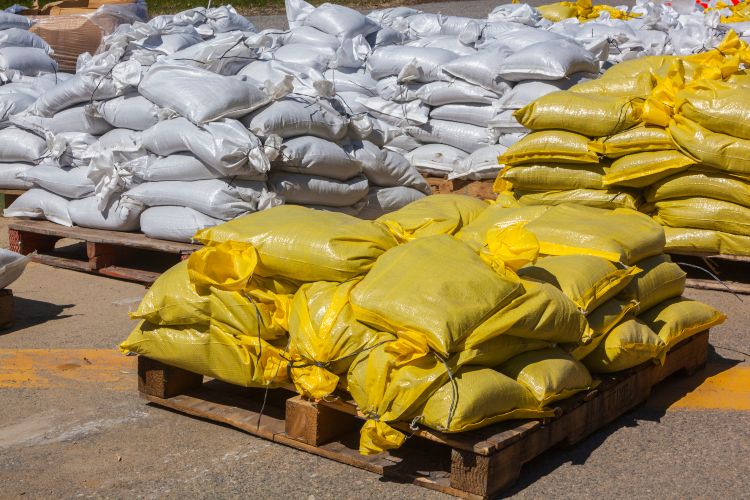Your Trusted Provider of Sandbags in Ogden, UT
Pre-filled sandbags can be used for a wide variety of purposes, including preventing water damage and soil erosion. Sandee’s Soil & Rock supplies quality, durable, and reliable pre-filled sandbags in Ogden, UT. We can help you determine what size sandbags are appropriate for your needs and how many you will need for your property or project. We can then deliver them to your home or business. Call now to request an estimate or learn more about our affordable sandbag services.

What Is Sandbagging, and When Do I Need to Do It?
Sandbags are durable, heavy-duty bags that are made of a plastic material or burlap. They are filled with sand or soil and strategically placed in areas that are at risk of flooding or soil erosion. Sandbagging is the process of using pre-filled sandbags to create strong barriers against floods and rainwater. If you live in an area that is at risk of flooding or experiences frequent heavy storms, placing sandbags in vulnerable areas can reduce your risk of water damage.
Types of Sandbags
Traditional sandbags are an effective way to deflect water and help protect structures from flooding. Sandbags can be made of burlap, polypropylene, polyethylene, and nylon. Any of these materials will suffice for sandbags, though nylon bags are coated with urethane for added water resistance, and they use double-stitched seams for increased durability. Consider nylon for a strong synthetic material that has minimal chance of tearing and leaking. There are a few different types of sandbags that you can choose from to protect your home or business:
- Traditional Sandbags – Traditional sandbags are heavy-duty bags made from nylon, canvas, plastic, or burlap. They are square or rectangular and available in a wide range of weights and sizes.
- Tube Sandbags – Tube sandbags or snake sandbags are long, tube-shaped bags made from plastic or canvas.
- Saddle Sandbags – Saddle sandbags are made from nylon and are small and compact. They consist of two small sandbags joined at the top with a carrying handle and are used to weigh down equipment to prevent it from falling over in windy conditions.
- Butterfly Sandbags – Butterfly sandbags or fly away sandbags are similar to saddle sandbags. They consist of two small nylon bags joined at the top and are used to weigh down objects that could fall over in a storm.
How to Use Heavy-Duty Sandbags
Before starting, measure the size of the areas that you need to protect and determine how high you want your sandbag wall to be. Then, measure the length of your sandbags to help you determine the number of sandbags you’ll need. To place your sandbags properly for ultimate protection from flooding, you should:
- Prepare the Site – Clear debris from the area where you want to build your sandbag wall. Don’t place sandbags on uneven ground or try to fit them around curves or sharp turns.
- Place the First Row of Sandbags – For sandbag placement, ensure that the bag flap is folded under, facing away from potential floodwater. If using a tied bag, flare the tied end out. Place the bag lengthwise, parallel to the direction of the water flow. Tamping down on the top of the sandbags before placing the next row will help create a better seal.
- Overlap Sandbags – When stacking the second and third rows, stagger the bags on top of the previous bag by offsetting by half the length on top of the previous bag, similar to the process for laying bricks or subway tiles.
- Shape High Barriers Like Pyramids – For barriers over three rows high, build the wall in a pyramid shape. The base of the pyramid should be three times wider than it is tall, with the bags overlapping at the seams.
Pre-filled Sandbags from Sandee’s
We offer high-quality, heavy-duty sandbags that offer superior resistance to flooding and moisture penetration. Our sandbag products and services include:
- 40 lb Sandbags – These sandbags have a 2,000-hour UV Lifespan and are also highly resistant to moisture intrusion. We sell them individually and by the pallet, with 40 bags per pallet.
- Pre-filled Sandbag Delivery – We can deliver sandbags to your home or office.
Where Can I Buy Sandbags? Sandbag Availability and Distribution
You can buy sandbags from Sandee’s Soil & Rock and pick them up yourself. We can also deliver them directly to your home or business. Our reliable delivery services are available throughout the Ogden, UT area, and our trucks can handle heavy loads. Just contact a friendly member of our sales team to arrange a delivery time.
Learn More About Sandbag Delivery in Ogden, UT
Sandee’s Soil & Rock is proud to be one of the most reliable sandbag stores in Ogden, UT. We are known for our quality products, reliable delivery services, affordable prices, and friendly, knowledgeable staff. We can help you choose the right type and number of sandbags to protect your home or business from dangerous and damaging flood waters. Call us now or contact us online to learn more about our pre-filled sandbag delivery services.
